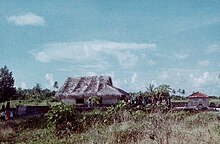Gen Mosque

| Gen Miskit | |
|---|---|
ގެން މިސްކިތް | |
 Gen Miskit in 1984 | |
| Religion | |
| Affiliation | Islam |
| Rite | Sunni / Sufism |
| Location | |
| Location | Dhadimagu, Fuvahmulah |
| State | Gnaviyani Atoll |
| Country | Maldives |
| Geographic coordinates | 0°17′54.1″S 73°25′37.1″E / 0.298361°S 73.426972°E |
| Architecture | |
| Style | Traditional Maldivian architecture |
| Date established | c. 1300 |
Gen Miskit (Dhivehi: ގެން މިސްކިތް; alternatively spelled as Gemmiskiy) is one of the oldest mosque in the Maldives built c. 1300[1][2] (before 1378).[3] It is made of coral stone and was built straight after the conversion to Islam.[4] It's noted that this mosque isn't facing towards the Qibla.[3]
Gen Miskit is located in the district of Dhadimagu at the northern end of Fuvahmulah.[2] It's now a revered site for its historical significance to the island.[5] It's the first mosque that the residents of the island did their Friday prayer and Eid prayers.[6][7]
There are disputes whether Gemmiskiy is the oldest mosque in the Maldives and in Fuvahmulah, media reports and residents say that it is the oldest but in a Monograph written by H.C.P. Bell, Fuvahmulah has had four mosques prior to Gen Miskit.[2][6][7] It is really uncertain.
There has been some concern about the extinction of the mosque due to lack of maintenance by the Fuvahmulah City Council.[8]
Features
[edit]The mosque has a communal well, a rectangular ancient circular bath known as ‘Genmiskiy Veyo’ and a cemetery with enclosed shrines “ziyaarat” of revered religious figures.[5]
Gemmiskiy Shrine
[edit]A place constructed with sandstone and protected by bricks.[5] It is also said that the person who built the mosque, Addu's Meedhoo Abu Bakr Naib Kaleygefaanu, is buried at and Ah Naib Al-Hafiz Abubakr, potentially the first proselytizer of Islam in the island.[5][9][7]
Gemmiskiy Veu
[edit]Gemmiskiy Veu or Veyo is a rectangulat bath that is adjacent to the Southeastern wall of the mosque that has waters going down into the waters.[5] It shares similarities with the baths in monasteries in Pokna and Anuradhapura in Sri Lanka.[5]
Gemmiskiy Well
[edit]The well is crafted from sandstones and has unique stories about it.[5] It is said by the residents of the island that the water tastes really sweet and each corner of the well has a unique taste.[6]
- Shrine, Gen Miskiy
- Veyo, Gen Miskiy
- Unmarked grave, Gen Miskiy
References
[edit]- ^ Sholeh, Muhammad (9 April 2021). "Mengenal Gen Miskit, Masjid Karang Pertama di Maldives" [Get to Know Gen Miskit, Maldives' First Coral Mosque]. Faktual News (in Indonesian). Retrieved 27 January 2022.
- ^ a b c Solih, Aishath Shuba (2 April 2024). "Fuvahmulah City – The Days of the Past and Reigning Ramadan Rituals". The Edition. Retrieved 19 June 2024.
- ^ a b "ާއާސާރީ މިސްކިތް ތަކުގެ ލިސްޓް" [List of ancient mosques] (PDF). Ministry of Islamic Affairs (in Divehi). p. 26. Retrieved 20 June 2024.
- ^ Mauroof, Mohamed Jameel; Ahmad, Yahaya. Coral Stone Mosques of Maldives: The Vanishing Legacy of the Indian Ocean. ORO Editions. ISBN 9780986281846. [page needed]
- ^ a b c d e f g "Gemmiskiy". Visit Fuvahmulah. Retrieved 19 June 2024.
- ^ a b c "ފުވައްމުލަކު ގެން މިސްކިތާއި ހަތަރުކަނުގައި ހަތަރު ރަހަލާކަމަށް ބުނާ ވަޅު" [The well in Fuvahmulah's Gen Miskit has four different unique tastes]. ThePress (in Divehi). 10 April 2023. Retrieved 20 June 2024.
- ^ a b c Hassan, Muneeru (3 September 2015). "ގެންމިސްކިތް: ފުވައްމުލަކުގެ އެންމެ ފުރަތަމަ މިސްކިތް" [Gen Miskit: Fuvahmulah's first mosque]. Sun (in Divehi). Retrieved 20 June 2024.
- ^ Hassan, Nimaa (12 March 2023). "ފުވައްމުލަކުގެ އާސާރުތައް ނުބެލެހެއްޓި ނެތިދަނީ". Adhadhu (in Divehi). Retrieved 20 June 2024.
- ^ "FUVAHMULAH HISTORY". Fuvahmulah City. 2 May 2024. Retrieved 19 June 2024.



